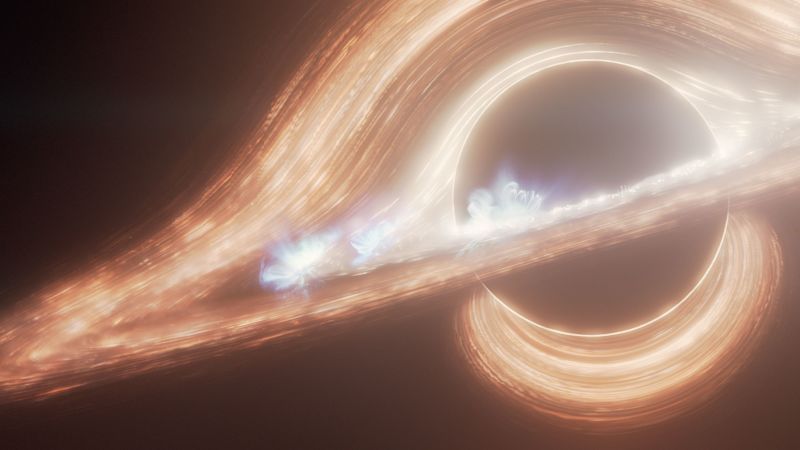Astronomers have made remarkable discoveries regarding the dynamic behavior of Sagittarius A*, the supermassive black hole located at the center of the Milky Way galaxy, using the advanced capabilities of the James Webb Space Telescope (JWST). This project has enabled scientists to observe rapid fluctuations of light emanating from the vicinity of the black hole, marking a significant leap in our understanding of how such celestial phenomena operate. The observations indicate a continuous display of flares that vary from brief flashes to more substantial bursts of light that occur daily.
The JWST’s findings represent the most extensive examination conducted around Sagittarius A* to date. Past research indicated that this black hole exhibited energetic activity; however, the Webb observations have unveiled a level of detail and continuity that was previously unattainable. The illumination emitted from the swirling disc of material, or accretion disk, surrounding Sagittarius A* resembles a dazzling display of fireworks, despite the black hole itself being invisible.
Astronomers propose that the flares result from occurrences at the inner edge of the accretion disk, which exists just beyond the event horizon, a boundary around a black hole where gravity is so intense that even light cannot escape. As Farhad Yusef-Zadeh, the lead author of the study and a professor at Northwestern University, explains, the data collected revealed a constant fluctuation of brightness interspersed with sudden bursts of intense illumination. Such randomness in the flaring activity suggests a complex interplay of forces at work, making the phenomena exciting for astronomers observing the black hole.
The investigation adds insight into the feeding mechanisms of black holes. The intense gravitational pull of black holes such as Sagittarius A* attracts gas and dust from wandering celestial bodies. As these materials spiral inward at high velocities, they create the characteristic accretion disk—its rapid motion results in heating and an eventual release of energy in various forms, including jets of material and radiation. Consequently, supermassive black holes play a crucial role in shaping the distribution of gas within galaxies and consequently influence star formation, acting as central engines driving these cosmic processes.
For their study, Yusef-Zadeh and his team diligently monitored Sagittarius A* over a period of 48 hours within one year, utilizing Webb’s Near-Infrared Camera. They documented approximately five to six significant flares daily, accompanied by smaller light emissions. Uniquely, unlike other supermassive black holes, Sagittarius A* was observed to be perpetually active rather than reaching a steady state. This heightened variability is likely due to the unpredictable flow of material entering the accretion disk.
The phenomenon of sporadic bursts of light has been likened to solar flares observed in the Sun, where magnetic fields converge and compress, leading to an outburst. Interestingly, the larger flares identified in the study may stem from magnetic reconnection events, where distinct magnetic fields collide near the black hole, unleashing powerful particles traveling at near-light speed. Such findings provide a broader understanding of the mechanisms triggering flares and their implications for the encompassing astronomical environment.
One notable aspect of the JWST observations was the ability to detect varying wavelengths of light simultaneously, likening the experience to transforming a black-and-white image into a vibrant color scene. This new perspective offered deeper insights into the nature of the flares and the underlying physical mechanisms, such as magnetic fields and flare density.
As the research advances, astronomers express enthusiasm for connecting various data sources to gain a comprehensive understanding of the phenomena surrounding Sagittarius A*. The consistency of the black hole’s variability aligns with earlier observations, suggesting persistent fluctuations in activity. Researchers are also eager to observe whether these flares demonstrate periodic characteristics or remain sporadic, paving the way for enhanced simulation of black hole accretion processes in the future.
Recognizing the potential implications of this research on galaxy evolution, astronomers remark on how such energetic events can impact star formation and the overall structure of galaxies. The desire for uninterrupted observations of Sagittarius A* for extended periods aims to gather critical data that could answer lingering questions regarding the black hole’s behavior and its role in the broader cosmic landscape.
In essence, the ongoing studies of Sagittarius A* highlight the significance of advanced technology like the James Webb Space Telescope in uncovering the mysteries of the universe. Future observations hold the promise of not only elucidating the peculiar behaviors of black holes but also enriching our understanding of their interactions with the surrounding cosmic environment and their integral roles in shaping the universe.












